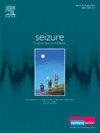ADAM23 haploinsufficiency as a putative oligogenic contributor in an individual with focal epilepsy
IF 2.8
3区 医学
Q2 CLINICAL NEUROLOGY
引用次数: 0
Abstract
Purpose
ADAM23 is involved in neuronal excitability and interacts with LGI1, a known genetic risk factor for focal epilepsy. While ADAM23 has been linked to canine seizures, a recent gene-burden meta-analysis first nominated it as a risk gene for epilepsy in humans. Building on these findings, our study aimed to explore the significance of truncating ADAM23 variants in deeply phenotyped individuals with diverse seizure disorders.
Methods
We screened the exome sequencing data from 389 individuals with various seizure phenotypes for truncating variants in ADAM23. This report focuses on one individual harboring a heterozygous frameshift variant in ADAM23, selected for detailed analysis due to intriguing additional genetic findings.
Results
We identified a heterozygous frameshift variant (c.428del, p.Asn143Ilefs*26) in ADAM23 (NM_003812.4) in a patient with drug-resistant, MRI-negative focal epilepsy accompanied by additional neurocognitive and behavioral issues. The ADAM23 variant was inherited from an unaffected parent. Notably, the same individual carried inherited, truncating variants in two other brain-expressed, loss-of-function-intolerant genes: TNRC6A and MAPK8IP3.
Conclusion
These findings suggest that ADAM23 contributes to epilepsy with reduced penetrance, potentially influenced by oligogenic factors. Although descriptive and hypothesis-generating, our data underscore the complexity of currently unexplored genetic contributions to epilepsy.
ADAM23单倍体功能不全是局灶性癫痫患者的推定寡基因因素
目的adam23参与神经元兴奋性并与LGI1相互作用,LGI1是局灶性癫痫的已知遗传危险因子。虽然ADAM23与犬类癫痫有关,但最近的一项基因负担荟萃分析首次将其列为人类癫痫的风险基因。在这些发现的基础上,我们的研究旨在探索截断ADAM23变异在不同癫痫疾病的深度表型个体中的意义。方法筛选389例不同癫痫表型患者的外显子组测序数据,寻找ADAM23的截断变异。本报告关注的是ADAM23中携带杂合移码变体的一个个体,由于有趣的其他遗传发现,选择该个体进行详细分析。我们在一名伴有额外神经认知和行为问题的耐药、mri阴性局灶性癫痫患者的ADAM23 (NM_003812.4)中发现了一个杂合移码变异(c.428del, p.Asn143Ilefs*26)。ADAM23变体从未受影响的亲本遗传。值得注意的是,同一个体携带了另外两个脑表达的、功能丧失的不耐受基因TNRC6A和MAPK8IP3的遗传截断变体。结论ADAM23在癫痫发病中的外显率较低,可能受少原性因素影响。尽管我们的数据是描述性的和假设生成的,但我们的数据强调了目前尚未探索的癫痫遗传贡献的复杂性。
本文章由计算机程序翻译,如有差异,请以英文原文为准。
求助全文
约1分钟内获得全文
求助全文
来源期刊

Seizure-European Journal of Epilepsy
医学-临床神经学
CiteScore
5.60
自引率
6.70%
发文量
231
审稿时长
34 days
期刊介绍:
Seizure - European Journal of Epilepsy is an international journal owned by Epilepsy Action (the largest member led epilepsy organisation in the UK). It provides a forum for papers on all topics related to epilepsy and seizure disorders.
 求助内容:
求助内容: 应助结果提醒方式:
应助结果提醒方式:


